The AMD Radeon RX Vega 64 & RX Vega 56 Review: Vega Burning Bright
by Ryan Smith & Nate Oh on August 14, 2017 9:00 AM ESTPower, Temperature, & Noise
Moving on from performance metrics, we’ll touch upon power, temperature, and noise. This is also normally where we’d discuss voltages, but as Vega is a new chip on a new architecture, nothing seems to read Vega 64 and 56 correctly.
In terms of average game clockspeeds, neither card maintains its boost specification at 100% with prolonged usage. Vega 64 tends to stay closer to its boost clocks, which is in line with its additional power overhead and higher temperature target over Vega 56.
| Radeon RX Vega Average Clockspeeds | ||
| Radeon RX Vega 64 Air | Radeon RX Vega 56 | |
| Boost Clocks |
1546MHz
|
1471MHz
|
| Max Boost (DPM7) |
1630MHz
|
1590MHz
|
| Battlefield 1 |
1512MHz
|
1337MHz
|
| Ashes: Escalation |
1542MHz
|
1354MHz
|
| DOOM |
1479MHz
|
1334MHz
|
| Ghost Recon: Wildlands |
1547MHz
|
1388MHz
|
| Dawn of War III |
1526MHz
|
1335MHz
|
| Deus Ex: Mankind Divided |
1498MHz
|
1348MHz
|
| GTA V |
1557MHz
|
1404MHz
|
| F1 2016 |
1526MHz
|
1394MHz
|
| FurMark |
1230MHz
HBM2: 868MHz |
1099MHz
HBM2: 773MHz |
With games, the HBM2 clocks ramp up and stay at their highest clock state. Expectedly, the strains of FurMark cause the cards to oscillate memory clocks: between 945MHz and 800MHZ for Vega 64, and between 800MHz and 700MHz for Vega 56. On that note, HBM2 comes with an idle power state (167MHz), an improvement on Fiji's HBM1 single power state. Unfortunately, the direct power savings are a little obscured since, as we will soon see, Vega 10 is a particularly power hungry chip.
As mentioned earlier, we used the default out-of-the-box configuration for power: Balanced, with the corresponding 220W GPU power limit. And under load, Vega needs power badly.
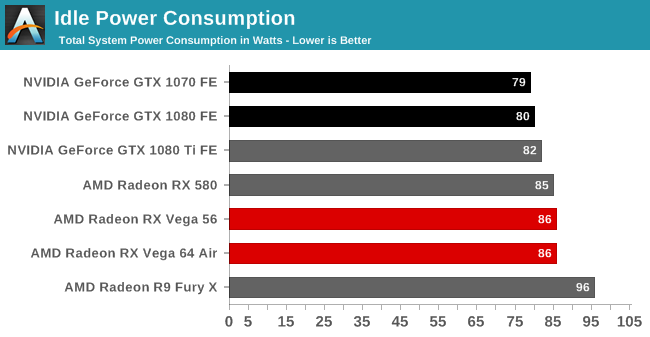
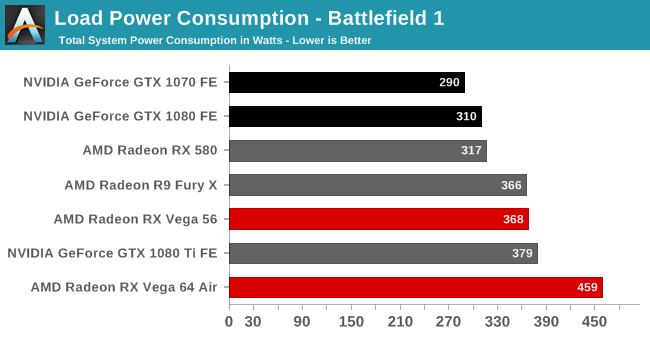
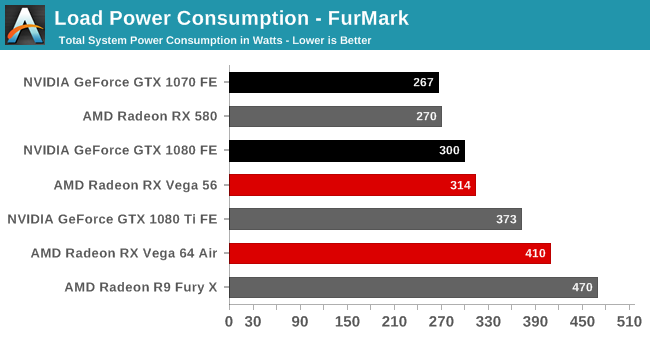
The performance of both Vega cards comes at a significant power cost. For the RX 500 series, we mused that load consumption is where AMD paid the piper. Here, the piper has taken AMD to the cleaners. In Battlefield 1, Vega 64 consumes 150W more system-wide power than the GTX 1080, its direct competitor. To be clear, additional power draw is expected, since Vega 64 is larger in both shader count (4096 vs. 2560) and die size (486mm2 vs. 314mm2) to the GTX 1080. But in that sense, when compared with the 1080 Ti, powered by the 471mm2 GP102, Vega 64 still consumes more power.
As for Vega 64's cut-down sibling, Vega 56's lower temperature target, lower clocks, and lower board power make its consumption look much more reasonable, although it is still well above the 1070.
In any case, the cooling solutions are able to do the job without severe effects on temperature and noise. As far as blowers go, RX Vega 64 and 56 are comparable to the 1080 Ti FE blower.
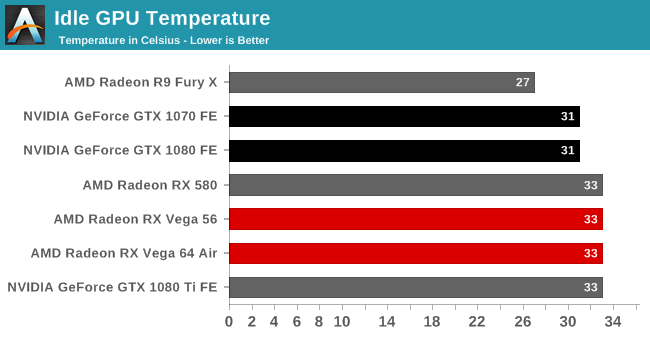
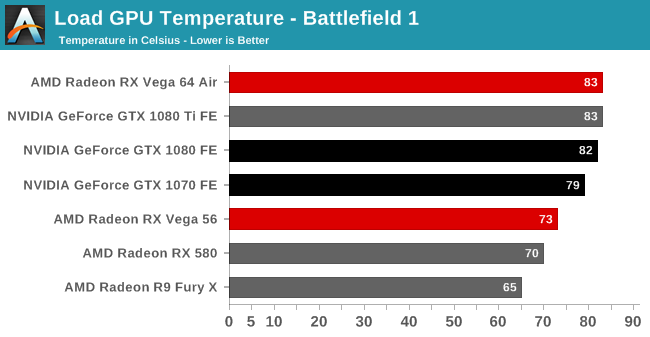

Not Graphed: Temperature of the actual Vega (Star): 9329C
Noise-testing equipment and methodology differ from past results, with a more sensitive noise meter and closer distance to the graphics card. Readings were also taken with an open case. As such, the noise levels may appear higher than expected.

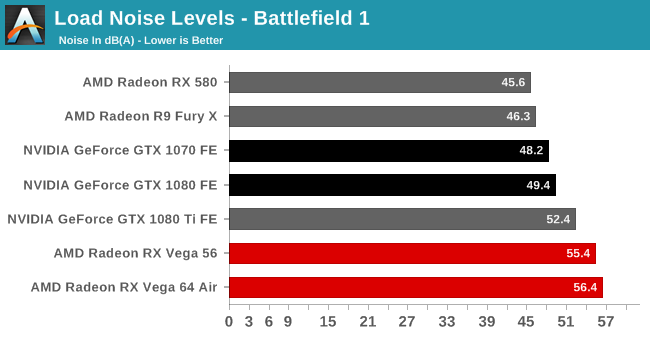
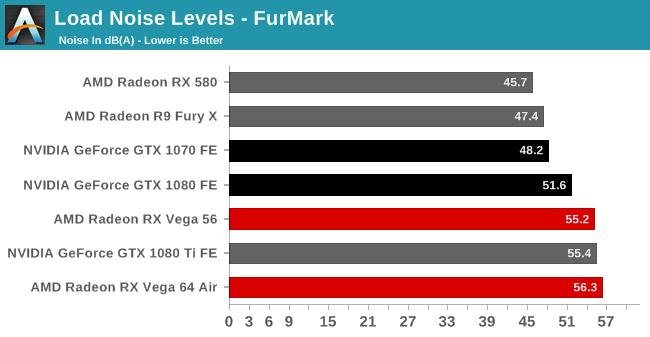










213 Comments
View All Comments
Otritus - Monday, August 14, 2017 - link
in the first page on the AMD Radeon RX Series Specification Comparison chart it says vega 56 has 3585 shaders instead of 3584 shadersOtritus - Monday, August 14, 2017 - link
gtx 1070 msrp is 349, price drop after 1080 tiTargon - Monday, August 14, 2017 - link
I'd be surprised if we don't need another two to three months to see how the Vega performance ends up with the expected driver updates. Every high end card from AMD and NVIDIA gets at least one big driver update to add 5-10 percent performance in games.Cellar Door - Monday, August 14, 2017 - link
Thanks for your excellent work Ryan.redwarrior - Tuesday, August 15, 2017 - link
Did you noter that the duynamic cache controller that AMD has touted is disabled at this point since the drivers have not been perfected to operate the cache efficiently. Once they solve that issue performance will jump anywhere from 10 to 15%. There is also some feature with the shaders that is also still disabled. All in all if we exercise a little patience Vega 64 should be a credible performer about half way between 1080 and 1080 Ti in performance. I hope when the drivers are more mature that people will do further reviews on these Vega offerings.AndrewJacksonZA - Tuesday, August 15, 2017 - link
Thank you Ryan.ddriver - Monday, August 14, 2017 - link
It seems amd still have a long way to do with the drivers, despite vega being so late... Judging by the battlefield result, a title that has both optimized for amd rather than exclusively for nvidia, and has been optimized on driver level by amd, this is where vega's actual graphics capabilities lie when it comes to the actual hardware, between the 1080 and the Ti.The good (for amd) news and bad (for people like me) is that vega looks like it has exceptional compute performance, which means prices will no doubt go through the roof because of the mining craze. This is not bad for gamers, since nvidia seems like the better value, but people who need compute for stuff other than mining will have to wait a while before vega could be bought at a good price.
TheinsanegamerN - Monday, August 14, 2017 - link
If we have to rely on AMD optimizing every single game for VEGA, we will never see its true potential. AMD couldnt manage to do it right in a year and some change.ddriver - Tuesday, August 15, 2017 - link
nvidia is pretty much doing that, they spend a tremendous amount of money doing other's work, money that amd is not in the position to spendScabies - Monday, August 14, 2017 - link
SR-IOV?